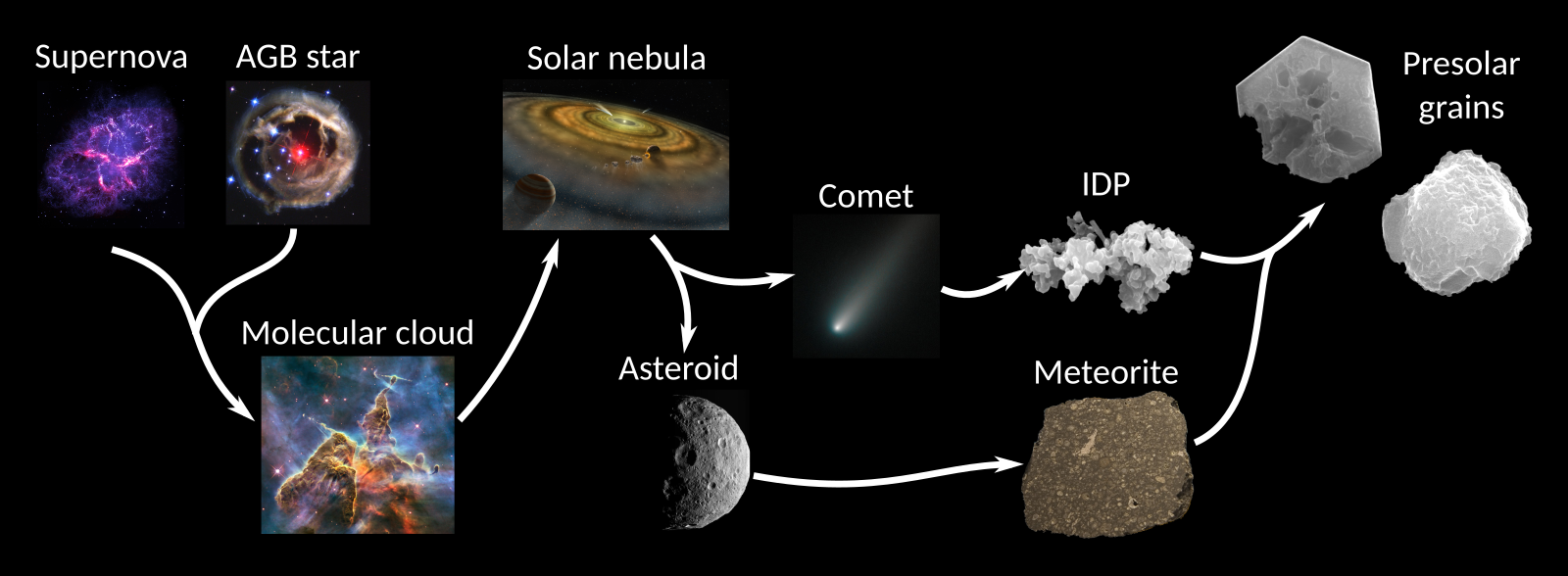Stardust

Formation and delivery
Stardust grains condensed in the outflows of dying stars and subsequently drifted through the interstellar medium. By chance some of these grains were present in the solar nebula and got incorporated in the precursors of meteorites. Some of these meteorite parent bodies have never been altered throughout the history of the solar system. Thus, we can extract stardust grains from such primitive meteorites and analyze them in the laboratory. This allows us to directly probe the nucleosythetic fingerprint of the parent star from which a specific stardust grain formed. Since these grains formed prior to the solar system they are often referred to as presolar grains. The figure below shows a schematic on how we picture the history of these samples.

The age of stardust grains
During their time in the interstellar medium stardust grains were irradiated with galactic cosmic rays, i.e., high-energy protons and 4He nuclei. These high-energy particles induced spallogenic reactions (click here for more information) in the stardust grain. In a recent study these spallogenically produced nuclides were measured to determinme how long stardust grains traveled from their birthplace to the early solar system, i.e., to determine their cosmic ray exposure age. We found that most grains have condensed up to around 100 million years prior to solar system formation, however, there were also some very old grain among the analyzed ones which formed more than 3 billion years before solar system formation. These samples are thus more than 7 billion years old, which is more than half the age of the Milky Way. Here you can find a more detailed article on this study.
Encoded stellar information
Aside from slight modifications in the interstellar medium, stardust grains carry the nucleosynthetic fingerprint of their parent star. This means that these grains can be used as direct probes to better understand the formation of elements and isotopes in stars as well as the evolution of isotopes over the history of the galaxy. Since different grains originated in different stars, various stellar environments can be probed. For example, so called mainstream grains originated in low-mass stars, which are the main hosts of the slow neutron capture (s-) process. These stars are responsible for producing around half of all elements heavier than iron. Mainstream grains can thus be directly used to probe this s-process and gain valuable insights into the inner working of these nucleosynthesis sites.
Some isotopes however, e.g., 54Fe and 60Ni are not significantly affected in low-mass stars, meaning that what comes out of the star also went originally in. Such isotopes are thus proxies for the material from which the mainstream grain’s parent star formed and allow us to trace galactic chemical evolution. You can find more or on this topic here
Analyzing stardust grains

The image above shows three different SiC grains that were extracted from the Murchison meteorite. The scalebars show that these grains are on the order of micrometers in size, and in fact, the grains shown here are large compared to many other SiC grains. As the name already says, SiC grains consist mainly of silicon and carbon. Elements of interest in order to study stellar nucleosynthesis and galactic chemical evolution are often only present in trace amounts. Special analytical techniques are thus required to get the most information out of these tiny samples. One of the most senstive techniques is resonance ionization mass spectrometry (RIMS). A description of its inner workings can be found here.